Challenges of Solo Trekking the EBC Trails
Solo trekking to the Everest Base Camp (EBC) trails presents several challenges due to the remote location and high-altitude terrain. Trekkers should be aware of these challenges before embarking on this journey, and careful planning and preparation are important to address potential difficulties. Some of the challenges of solo trekking to the EBC include the following:
- Logistics: The EBC route is located in a remote area, so it is difficult to arrange a lot of logistics, such as transport, accommodation, and supplies. If you go with a guide, an agency and the guide can help with these tasks, making the trek much easier and more enjoyable.
- Navigation: The trail to Everest Base Camp is challenging and confusing without a guide, it is easy to get lost, especially in bad weather or low visibility conditions. A guide can provide valuable assistance in navigating the trail, ensuring that you stay on the right path, and offering flexibility along the way.
- Safety Risks: The EBC trekking route passes through high-altitude terrains, making solo trekkers more helpless to accidents and injuries, with limited access to immediate help in remote areas. Trekking alone can be dangerous in these conditions, and having someone with you in an emergency is necessary.
- Weather conditions and Communication: The weather in the Himalayas can be changeable and harsh, with sudden changes that can make trekking dangerous. In these cases, solo trekkers need quick access to help. Mobile network coverage can be sparse, making it difficult to communicate in emergencies.
- Altitude Sickness: The EBC route starts at 2,800 meters and ascends to 5,364 meters at Everest Base Camp. If you gain altitude, the risk of altitude sickness increases. Symptoms can include headaches, nausea, dizziness, and fatigue. It is necessary to have a flexible itinerary for proper acclimatization, as acclimatization is important.
To avoid these challenges, choosing a reputable trekking organizer and hiring an experienced guide is essential for a safe and successful trek to EBC.
Hiring Guide from Kathmandu vs Lukla to EBC Trek
When deciding whether to hire a guide from Kathmandu or Lukla for your Everest Base Camp (EBC) trek, there are different feature between them but both options have their merits, and the best choice depends on your preferences, budget, and the level of preparation you want. Hiring a guide from Kathmandu may offer more comprehensive pre-trek planning and established relationships, while hiring from Lukla provides local expertise and avoids additional travel costs.
- Hiring a Guide from Kathmandu:
Guides from Kathmandu are often well-prepared and familiar with the entire trek, including logistics, route planning, and acclimatization due to their extensive experience. Local guides from Kathmandu may have established relationships with accommodation providers, which can sometimes lead to better arrangements and prices. These guides might have more extensive training and experience, given their ability to work with various trekking routes and high-altitude environments. However, guide hired in Kathmandu, need to travel to Lukla with trekkers, its increases their costs because need to charge more to cover their travel expenses to and from the trekking starting point.
- Hiring a Guide from Lukla:
Guides hire in Lukla might have lower overall costs due to reduced travel expenses and local pricing. They are likely to have recent, hands-on experience with the Everest Base Camp (EBC) route and can provide up-to-date information about local conditions and accommodations. By hiring a guide in Lukla, you avoid additional expenses for travel from Kathmandu. Guides in Lukla are often readily available and can be hired on short notice if needed. However, you might miss out on pre-trek preparation and planning, as the guide may focus more on the immediate trek rather than broader logistics. Depending on availability and demand, hiring a guide in Lukla could be more expensive due to the immediate need and high demand.
Luggage Load Carried by Porters during the EBC Trek
If you are trekking in Nepal with just a guide, the guide will not carry your luggage because they are professionals and have their own luggage to carry. In this case, you can hire a porter-cum-guide who handles both guiding and carrying your luggage, typically about 10 to 12 kg. If you are in a group, we usually assign one porter for every two trekkers, so each trekker's luggage should weigh around 10 kg. A porter typically carries 20 to 25 kg during the trek in Nepal. Trekking with both a guide and a porter makes walking easier and gives you more free time to enjoy the trek, resulting in a memorable trekking experience in Nepal.
How to reach Everest Region
Located in the northeastern part of Nepal and Protected by Sagarmatha national park, the Everest region can be reached in different ways direct flights to Lukla from Kathmandu, Jiri, or Phaphlu are among the most common ways due to the unavailability of direct road links. Taking the bus to Jiri takes a 4-5 days trek and 2-3 days for Phaplu to enter the region.
About Lukla Flight
Lukla is the small town and starting point of all trekking to the Everest region in Nepal. There is no direct road link to Lukla from Kathmandu due to which trekkers to Lukla either have to fly to the Tensing Hillary or Lukla airport or trek from Phaplu or Jiri. Many airlines operate regular flights from Kathmandu.
The weight limit of the luggage bag is 12 kg and an extra cost is to be charged for the extra weight at the airport. We suggest you make less weight than 15 kg because Sometimes overload in a plane can cause you to replace the luggage on the next flight which could take more time.
Please be responsive in taking a smaller aircraft for the flight to the highlands. Sometimes, the weather could be bad and crucial resulting in delaying the flights to and from Kathmandu-Lukla-Kathmandu. Himalayan and Hilly Region weather can be changeable. But, we will try to make the best itinerary days possible. In case of flight delay and cancellation, you’ll need an extra few days before and after the trekking days from the itinerary. Because our trekking staff are experienced and professional in trekking as well as problem-solving so there are fewer chances of miss handling the situation.
Accommodation in Guide Hire for Everest Base Camp Trek
The Everest Base Camp Trek has many tea houses along the route that provide meals and accommodation. Because of its popularity, finding good accommodation in the region is usually not a problem. Most tea houses offer good-quality services.
Typically, lodges have private rooms with two beds and shared indoor bathrooms. If you prefer more comfort, luxury lodges with better facilities are available, though some locations have limited options. The quality of lodges varies by location, so you can choose according to your budget. In places like Lukla, Phakding, and Namche, luxury lodges offer comfortable beds, attached bathrooms, hot showers, and better food.
When hiring a guide for the Everest Base Camp (EBC) Trek, you need to cover their food and accommodation costs. Most tea houses have warm dining halls with a fireplace where you can enjoy your meals.
Food in Guide Hire for Everest Base Camp Trek
Tea houses serve a variety of meals, but as you go higher, the options become more limited. The most common and recommended meal is Dal Bhat, a high-energy meal with unlimited refills. Every lodge has a menu with similar food items, but you are free to choose from it. The cooks are skilled, but the taste of the food may be different from Western cuisine. Since meat is scarce in the mountains, we recommend trying vegetarian dishes.
Typical Meals
Breakfast:
- Tibetan bread with jam/honey
- Porridge or muesli
- Pancakes
- Eggs (boiled, scrambled, or omelet)
- Tea/coffee
Lunch/Dinner:
- Dal Bhat (rice, lentil soup, vegetables, pickles) – best choice for energy
- Noodles (vegetable, egg, or chicken)
- Fried rice (vegetable, egg, or chicken)
- Momo (Tibetan dumplings)
- Pasta, macaroni, or pizza (available in some places)
- Garlic soup (good for altitude sickness prevention)
Snacks & Drinks:
- Tea (black, green, ginger, mint, etc.)
- Coffee (instant or brewed at lower altitudes)
- Energy bars, chocolates, biscuits
- Boiled water ($1-$4 per liter) – refilling is better than buying plastic bottles.
Best Season for Guide Hire for Everest Base Camp Trek
Hiring a licensed guide for the Everest Base Camp (EBC) Trek is important for a safe and well-organized experience, and choosing the right season can make your trek more successful. The best times to hire a guide for the Everest Base Camp Trek are spring (March-May) and autumn (September-November) because of good weather, clear trails, and a safer trekking experience. If you prefer a quieter trek, early December or late February are also great options.
Spring (March to May) – The best season for trekking due to mild temperatures and clear skies, offering perfect conditions. The rhododendron blooms create beautiful landscapes, especially at lower altitudes like below Pangboche. The weather is stable, with less chance of rain or snow. Besides trekking, this season is also ideal for climbing, making it perfect for trekkers attempting Island Peak or Lobuche Peak. Since its peak trekking season, tea houses fill up quickly.
Autumn (September to November) – Another great season for trekking due to stable weather and clear skies, offering ideal conditions for breathtaking views after the monsoon. With mild to cool temperatures, it’s perfect for trekking, as it falls between the monsoon and winter. You may also experience Dashain and Tihar, Nepal’s biggest festivals, which take place during this season. Autumn sees high trekking traffic, so like spring, it’s a busy season, and early bookings are recommended.
Winter (December to February) - is an alternative choice, offering cold but peaceful conditions. It’s less crowded, with fewer trekkers, meaning quieter trails and easier accommodation. Early winter brings clear skies and great mountain views, especially in December and early January. However, the temperatures will be very cold (-10°C to -20°C at higher altitudes), requiring extra gear. There is also a possibility of heavy snowfall, which could close some passes and trails. These challenges are something to consider if trekking to Everest Base Camp during winter.
Monsoon (June to August) - is not recommended for the Everest Base Camp Trek due to poor visibility, which can delay the completion of the trek. Flights to Lukla from Kathmandu are often disrupted during this time. Heavy rain and clouds make the trails slippery, and there is a risk of flight cancellations to/from Lukla. However, the monsoon season offers lush green landscapes in the lower valleys due to the rain, and with fewer trekkers, the trails are peaceful.
Everest Base Camp Trek Difficulty
The Everest Base Camp (EBC) Trek is considered moderate to challenging, depending on factors such as your fitness level, acclimatization, and weather conditions. Everest Base Camp sits at 5,364 meters (17,598 feet) above sea level, so there’s a risk of altitude sickness. Proper acclimatization is essential to prevent this, and the trek involves several days of gradual ascent to aid with acclimatization. That’s why it’s recommended to include rest days in Namche Bazaar and Dingboche for proper acclimatization.
The trek typically lasts between 12 to 14 days, including acclimatization days, and requires walking 5-8 hours per day. Some days may involve longer treks, especially on uphill sections with rocky and high-altitude terrain. The weather can be cold with wind chill, even during the best seasons (spring and autumn), with temperatures often dropping well below freezing at higher altitudes, especially at night.
A good level of physical fitness is essential to manage long trekking hours, steep climbs, and the physical exertion of high-altitude trekking. For first-time trekkers to Everest Base Camp, endurance is key. The ability to maintain a steady pace, hike for several days in a row, and handle altitude will be important. Also, drink plenty of water to help with acclimatization and overall well-being.
Requires Permits & Permits Cost for the EBC Trek
The Everest Base Camp (EBC) trekking route is located within Sagarmatha National Park in the Khumbu Pasang Lhamu Rural Municipality, in the Everest region of Nepal. Therefore, you need to obtain both a Sagarmatha National Park entrance permit and a Khumbu Pasang Lhamu Rural Municipality entrance permit. Another required permit is the TIMS (Trekkers' Information Management System) card, which is for your safety and security as it helps track trekkers' whereabouts in the region. Both permits are mandatory for the Everest Base Camp trek.
The Sagarmatha National Park entrance permit and TIMS card can be obtained through a reputable trekking company at the Tourism Board (Bhrikuti Mandap) in Kathmandu. Additionally, the Sagarmatha National Park entrance permit can be purchased in Monjo, and the Khumbu Pasang Lhamu Rural Municipality entrance permit can buy in Lukla after starting the trek. You or your guide must carry these permits throughout the trek, as they must be shown and registered at every checkpoint along the trail. If you attempt to trek without these permits, you will have to purchase them on-site at double the cost as a penalty, or you may be forced to turn back.
Khumbu Pasang Lhamu Rural Municipality entrance permits
- Cost: US$ 30 per person, per trek for all foreigners
- Cost: US$ 20 per person for SAARC (South Asian Association for Regional Cooperation) citizens
TIMS (Trekkers Information Management System) Card:
- Cost: US$ 20 per person, per trek
Sagarmatha National Park Entrance Fees:
- Cost: US$ 30 per person, per trek for all foreigners
- Cost: US$ 15 per person for SAARC (South Asian Association for Regional Cooperation) citizens
Communication in the Everest Region
There is good mobile network service around the Everest base camp trekking area but not around Gokyo Valley and Chukkung Valley. The internet service is available in the whole of the Everest Region but teahouses and lodges provide the internet with some extra charges. In case of not have a Nepali sim card, our Nepali guide will help you contact your family and update the head office about the trek.
Because traveling is a part of human life and tourism is as old as human civilization, we have been working to make travel more enjoyable.
Acclimatization:
When traveling to higher elevations in the high Himalayan region, high altitude sickness is a regular problem. Although it develops fairly quickly, the symptoms can be avoided. If you have prior high-altitude trekking experience, it might be preferable, but if not, you should take precautions to avoid high-altitude sickness if you plan to walk over three thousand meters. In order to avoid altitude sickness while trekking in Nepal, you should walk carefully, drink enough water, abstain from alcohol, ascend higher, and sleep at low elevation. You should also spend two nights for every 500 meters over the elevation of 3500 meters. All of our trekking routes are adaptable and include days for acclimatization. Your health and safety come first so that you may complete the trek without incident. In case things worsen, we give you some essential medications to help with an emergency rescue.
As a result, you must advise your Guide or Leader of your health status each day. Based on his reaction, he will decide whether or not to let you continue on your trip.
Tipping Information:
During your tour, trekking, and other activities in Nepal, the guide, porter, driver, and all other employees who work in the tourism industry expect tips. Tipping is how customers evaluate service providers, and service providers accept tips at the end of a journey. Travelers often tip 10% of their billable amount, but you can give more or less depending on the quality of the service.
Therefore, it is crucial that the High Pass Adventure working team takes good care of you at all times while you are visiting Nepal, is inspired by exceptional service, and provides inspirational once-in-a-lifetime experiences.
Trip Extension:
After finishing the walk, if you have extra time, you can engage in other activities or go on another quick trek in Nepal. Chitwan National Park and Bardiya National Park for jungle safari excursions are only two of our many short travel packages and adventure activities. You can go sightseeing in Pokhara, go trekking in Nagarkot or Dhampus, or go rafting for the day on the Trisuli River.
Paragliding, kayaking, ultra light flight, bungee jumping, and mountain biking are examples of adventure sports. These are all optional add-on activities to your package that are not included in the price. If you choose to participate in these activities with us after your vacation, we will organize them at a fair price and give you a generous discount.
Trekking gear list
Before departing, you must pack your trip necessities. We hope it would be too much for you to transport from your country to another, but some of the necessary equipment may be rented or purchased in Kathmandu's Thamel area. While trekking in Nepal, this basic gear is appropriate for all seasons, though it may vary depending on the season and length of the trekking routes you choose to take.
1) Requirement Documents:
- Passport and 4 passport size photos
- Travel insurance details (in case an emergency evacuation if needed)
- Boarding passes for flights
- Driver’s license (if needed)
- Cash USD
- Credit/Debit Card (Ensure you have $500 on your card in case an emergency helicopter evacuation is needed)
2) Logistic Things
- Sleeping bag (Comfort rating -15 Celsius recommended)
- Sleeping bag liner (Optional)
3) Footwear Things
- Trekking boots: one pair lightweight
- Sandals for city and tea house footwear
- Shoes for the plane and tea houses (Optional)
- Gaiters for hiking in winter to the base camp
- Thin, lightweight inner socks
- Thick, warm wool hiking socks
4) Clothing for Body
(Please make sure that you have non-cotton clothing for trekking)
- Base-layer t-shirts (e.g. running t-shirts)
- Fleece/Windproof jacket
- Waterproof jacket
- Down jacket for warmth
- Travel clothes and City Wear
- Underwear
- Base-layer trousers (optional)
- Waterproof trousers
- Trekking trousers
- Trekking shorts (Optional)
- Gloves and wool hat
- bandanna or scarf
5) Health Requirements (Basic First Aid Kit)
- First-aid kit; should contain lip salve, Aspirin, Band Aids, anti-histamine, Imodium or similar tablets for mild cases of diarrhea
- Re-hydration powder, extra prescription drugs you may be taking if any particular
- Wet wipes for cleaning can be purchased in Kathmandu
6) Others Necessary Things:
- Sunglasses and Sun cream
- Towel
- Book (reading and writing materials)
- MP-3 /Music, headphones and ear plug (who know some people on group are snoring) as optional.
- Travel wash
- Hand sanitizer, wet wipes
- A day bag: 35 liters
- A duffel or rucksack with straps to go over your back (Max 12 kg of weight for porters to carry)
- Dry Liner or Dry Bag
- Water bottle/thermos/ camel bag: At least 2 L. Nalgen bottles best.
7) General Toiletries
- Toilet papers/ tissue
- Contact lenses, Glasses (if needed)
- 1 medium sized quick drying towel
- Tooth brush/paste (preferably biodegradable)
- Multipurpose soaps (preferably biodegradable)
- Nail clippers
- Face and body moisturizer
- Feminine hygiene products
- Small mirror
- On Personal Hygiene
- Wet wipes (baby wipes)
- Anti-bacterial hand wash
8) Others (Optional) Things
- Trekking Poles
- Large plastic bags – for keeping items dry inside your kit / duffel bag
- Travel game i.e. chess, backgammon, and scrabble. (for luxuries)
- Binoculars (for luxuries)
- Trail Map/Guide book (if you are alone)


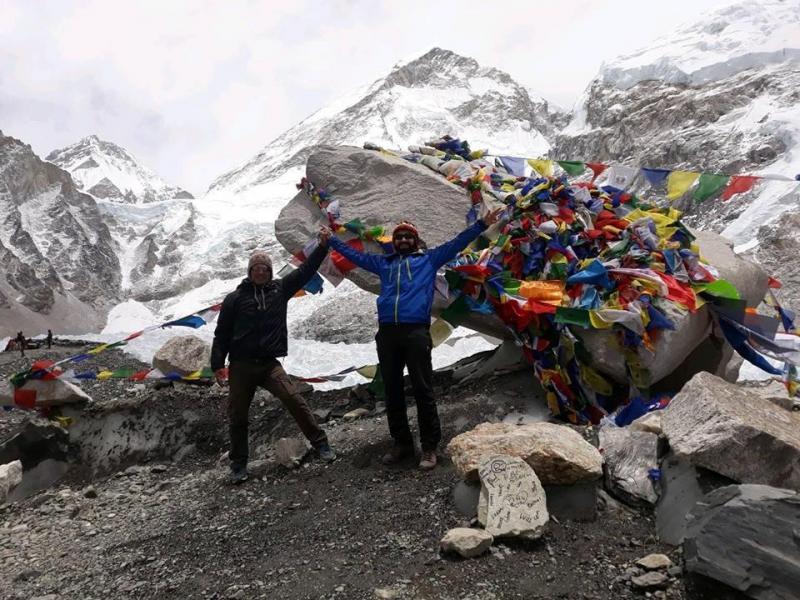

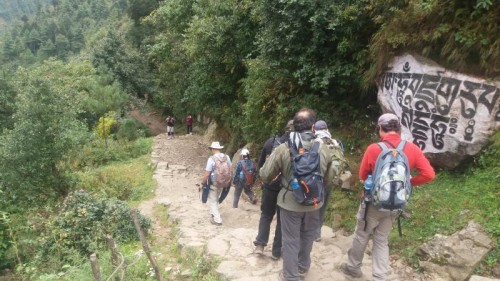

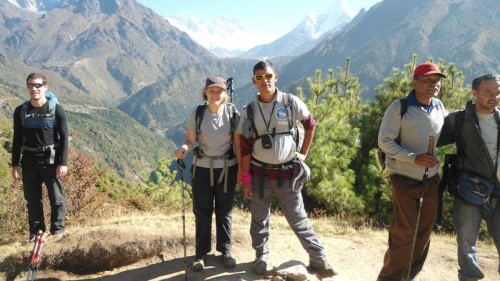

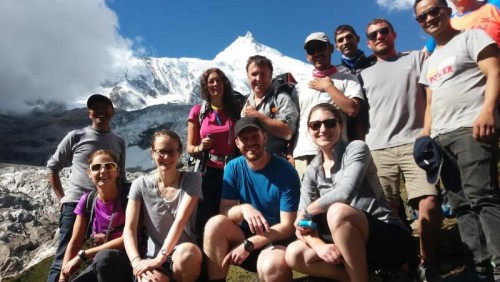
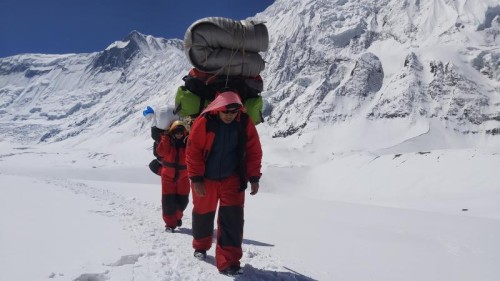
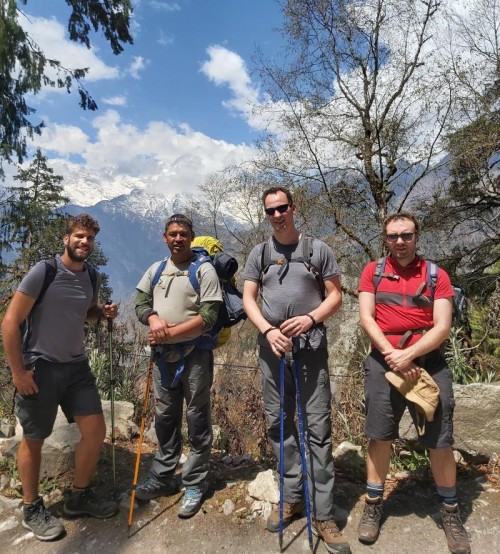


 USD 30
USD 30



